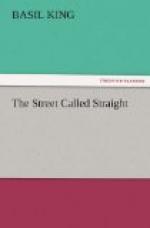It was a large room, with windows on three sides, through which the light poured in to find itself refracted by a hundred lustrous surfaces. The first impression received on entering what Rodney Temple called his work-room was that of color—color unlike that of pictures, flowers, gems, or sunsets, and yet of extraordinary richness and variety. Low bookcases, running round the room, offered on the broad shelf forming the top space for many specimens of that potter’s art on which the old man had made himself an authority. Jars and vases stood on tables, plaques and platters hung on the walls, each notable for some excellence in shape, glaze, or decoration. Of Americans of his generation Rodney Temple had been among the first to respond to an appeal that came from ages immeasurably far back in the history of man. His imagination had been stirred in boyhood by watching a common country potter turn off bowls and flowerpots that sprang from the wheel in exquisite, concentric forms or like opening lilies of red earth. Here, he had said to himself, is the beginning of everything we call art—here must have been the first intimation to man that beauty could be an element in the work of his own fingers.
In a handicraft that took the dust of the earth to minister to man’s humblest needs, and yet contrived thereby to enrich his aesthetic life, young Rodney Temple, as he was then, found much that was congenial to his own mystical aspirations. During his early travels abroad the factories of Meissen and Sevres interested him more than the Zwinger and the Louvre.
He frequented the booths and quays and dingy streets of the older European cities, bringing out from some lost hiding-place now an Arabic tile in which the green of the oasis intensified the blue of the desert sky; now a Persian bowl of hues that changed with a turn of the head or a quiver of the lids; now a Spanish plaque gleaming with metallic, opalescent colors, too indefinable to name, too fugitive for the eye to transmit to memory. Later he picked up strange examples which, like meteoric stones from another sphere, had found their mysterious way from Chinese palaces to his grimy haunts in London, Amsterdam, or Florence, as the case might be—a blue-and-white jar of Chia-ching, or a Han ceremonial vessel in emerald green, incrusted from long burial, or a celadon bowl that resembled a cup of jade, or some gorgeously decorated bit of Famille Verte. He knew at first little or nothing of the nature and history of these precious “finds.” He saw only that they were rare and lovely and that through beauty as a means of grace he entered into communion with men who had neither epoch nor ideals in common with himself.




